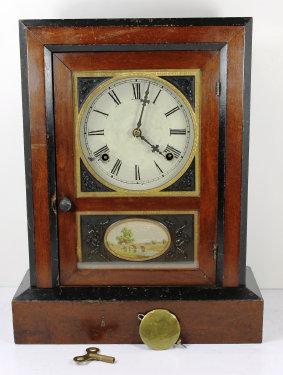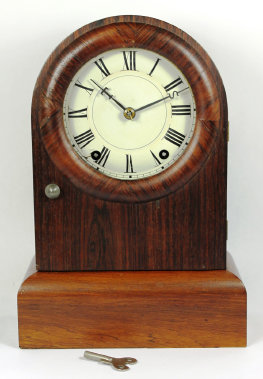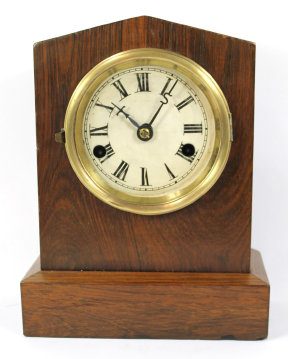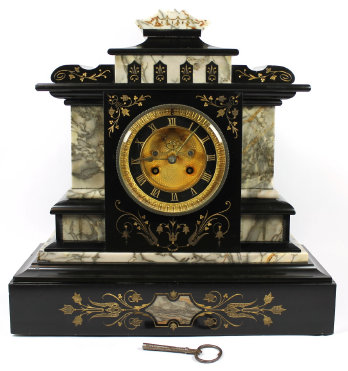


409. $750
Eli Terry & Sons “Pillar & Scroll”, 1823-1831. For 8 years Terry & Sons were prolific
producers of 30-hour pillar & scroll and stenciled column clocks, after which Eli Sr. retired. This wooden works clock is
in excellent and original condition. The door veneer is intact, there is an ivory escutcheon with a working latch and key, the
upper and lower glasses appear original. There is considerable flaking to the tablet but the image is there. It’s at that
stage where it could be repainted, but doesn’t have to be. Because so much of it remains it could be repainted to match the
original. Of course the scrolls have been broken and repaired, but the repairs are barely noticeable. The brass urn finials
have brass posts and no vertical seams. There also are two repairs to the veneer on the base, but the scrolled trim and feet
look original. The wood dial is typical of Terry clocks of this period, very clean with no losses. The movement
is very clean and the gears show no breaks or missing teeth. The weight cord on the time side is broken so we did not hang a
weight, but the gears turn by hand and the escape wheel turns. The strike side is working, striking the iron bell. There
is only one set of holes in the vertical supports for holding the movement in place, with the pins in place. The interior label
is complete and easily read – “N.B. The public may be assured that this kind of Clock will run as long without repairs, and be as
durable and accurate for keeping time, as any kind of Clock whatever.” $800-$1500.

410. $100
Jerome & Co. cottage, ca. 1875. The patent date of 1870 on the door label dates this clock
to after purchase of the company by the New Haven Clock Co. The mahogany-veneered clock is just under 16 inches tall with black
painted trim all around. Some wear is evident, especially around the door latch. There is what appears to be a burn mark
on the top surface, but it doesn’t detract significantly. The metal dial retains most of the original paint and is relatively
clean; the hands are appropriate but do not quite match. The gutta percha inserts with gold trim are in good shape, no cracks,
with a typical idyllic country picture. The interior retains the original wallpaper. The 8-day time-and-strike unsigned
movement is running and striking a wire gong. A nice example of this model. $100-$200.


412. $75
Seth Thomas “Tudor No. 3”, ca. 1881. The rosewood-veneered case is 12 inches tall. The veneer is missing a few small segments on the bezel and the veneer is loose along the bottom of the door. The glass is old
and bubbly, the door knob original, and there is an excellent label inside the door. The metal dial has been repainted, the
ST hands newer. The signed small lyre 8-day movement is keeping time and striking a wire gong on the hour and half-hour. One of 40 cottage clocks made by Seth Thomas. Got ‘em all? $100-$180.
411. $400
French Art Deco onyx clock, ca. 1920. This beautiful archetypal art deco clock is 12.5
inches tall and 12.25 inches wide, with a white onyx base and top and green onyx accents in front and on top. Can’t you just
see Fred Astaire and Ginger Rogers dancing around a room that looked like this clock? Beveled glasses all around, bright brass
framing with two curved metal mirrors on either side (forming an ogee curve), and a fancy brass diamond-shaped pendulum. The
onyx is clean and crack-free. The metal dial is rather dark but I think it was designed that way, as it does not show uneven
oxidation, wear, or soiling. The pendule de Paris movement (signed Marti) has an outside count wheel and strikes a bell on the
hour and half-hour. The strike arm needs a bit of adjustment to properly strike the bell; the movement and pendulum have matching
numbers. The clock is running and striking on cue. $500-$1000.

413. $100
Seth Thomas “Cabinet No. 2”, ca. 1870. Just 9 inches high by 7 inches wide, in rosewood
veneer with a brass bezel, newer glass, and a repainted metal dial with replacement ST hands. The 30-hour movement appears to
be the J-type, signed, running and striking on the hour on an iron bell. A couple of veneer chips at the base. You hang
the pendulum bob from underneath. There is just a remnant of a label on the back. No sales anywhere that I can find. $125-$175 estimated, based on similar clocks.

414. $175
French black marble clock, ca. 1890. This marble clock is 14 inches high and 14 inches
across, in black marble (Belgian slate) with white marble accents. There are black inlays in the white marble, and a grey/white
marble inlay in the base. There are gold-filled incisings all around. The gold-and-black dial sits behind a thick beveled
glass. The visible escapement has ruby pallets. The pendule á Paris movement is signed “Marti” and numbered, and the pendulum
has a matching number. It strikes a gong on the hour and half-hour, and is running and keeping time. It is missing a brass
button foot on the right rear, but other than a few flea-bites to the marble edges of the base, this clock is in excellent condition. $250-$500.